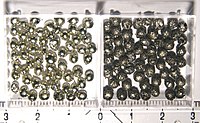
Photo from wikipedia
Memristor, processing data storage and logic operation all-in-one, is an advanced configuration for next generation computer. In this work, a bismuth doped tin oxide (Bi:SnO2 ) memristor with ITO/Bi:SnO2 /TiN… Click to show full abstract
Memristor, processing data storage and logic operation all-in-one, is an advanced configuration for next generation computer. In this work, a bismuth doped tin oxide (Bi:SnO2 ) memristor with ITO/Bi:SnO2 /TiN structure has been fabricated. Observing from transmission electron microscope (TEM) for the Bi:SnO2 device, it is found that the bismuth atoms surround the surface of SnO2 crystals to form the coaxial Bi conductive filament. The self-compliance current, switching voltage and operating current of Bi:SnO2 memristor are remarkably smaller than that of ITO/SnO2 /TiN device. With the content of 4.8% Bi doping, the SET operating power of doped device is 16 µW for ITO/Bi:SnO2 /TiN memory cell of 0.4 × 0.4 µm2 , which is cut down by two orders of magnitude. Hence, the findings in this study suggest that Bi:SnO2 memristors hold significant potential for application in low power memory and broadening the understanding of existing resistive switching (RS) mechanism.
Journal Title: Small
Year Published: 2020
Link to full text (if available)
Share on Social Media: Sign Up to like & get
recommendations!